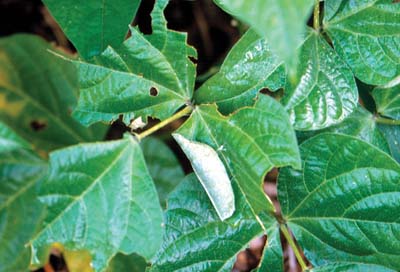
Bean leafroller damage to beans.
(Photographer: J. Castner, University of Florida)
While this species is a serious garden pest, it is not a serious issue in commercial vegetable production. The bean leafroller feeds on cowpea, lima bean, pea, snap bean, and soybean. The larvae defoliate the plants feeding only on leafy tissue of legumes (bean and its relatives). The larva cuts a small patch in the edge of the leaf, folds over the flap, and takes up residence within this shelter. The larva leaves this shelter to feed at night. Sampling of the bean leafroller is usually accomplished by visual observation. Economic thresholds are established for beans and levels are set at 140 eggs or 70 first stage larvae per plant. Most insecticides that are applied to the foliage are very effective in suppression of bean leafroller populations. Many biological control agents are naturally occurring but no biological control agents are commercially available.
Images
To save the Web-optimized images shown below to your hard drive:
|
Click to access Display and Print quality images. |
|
Click to access Display and Print quality images. |
|
Click to access Display and Print quality images. |
|
Click to access Display and Print quality images. |
|
Click to access Display and Print quality images. |
|
Click to access Display and Print quality images. |